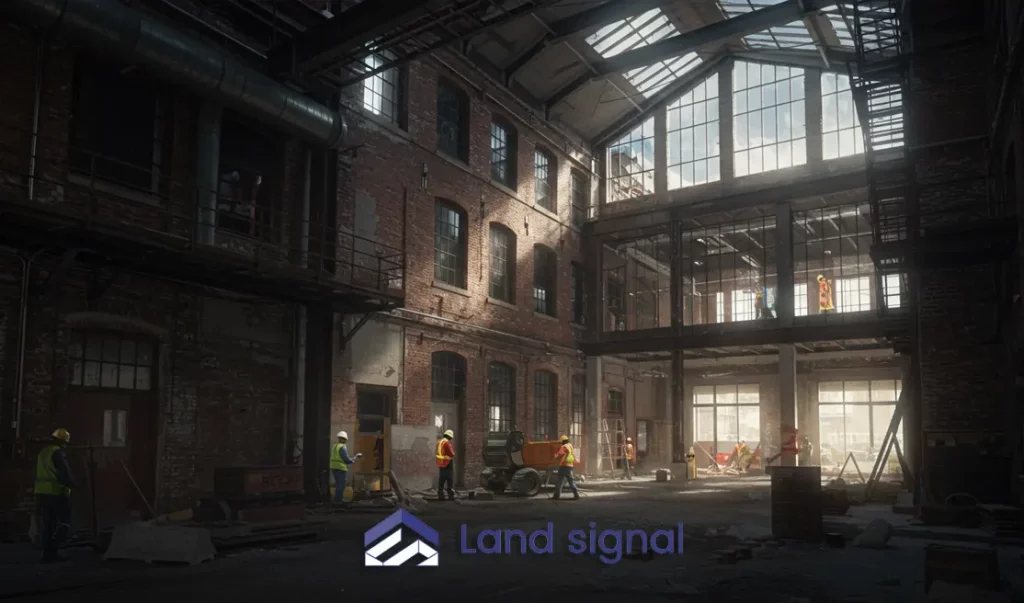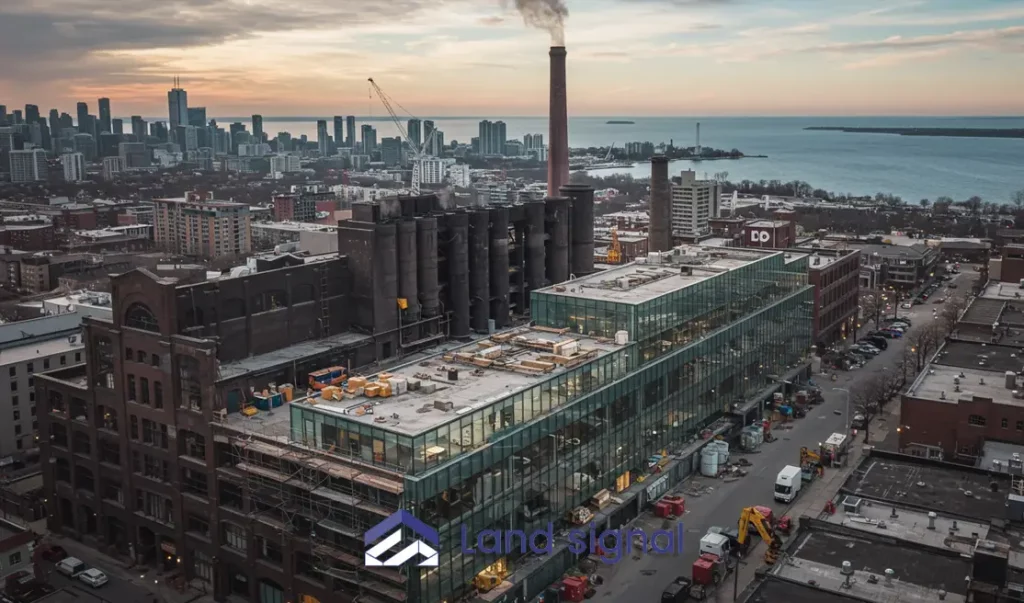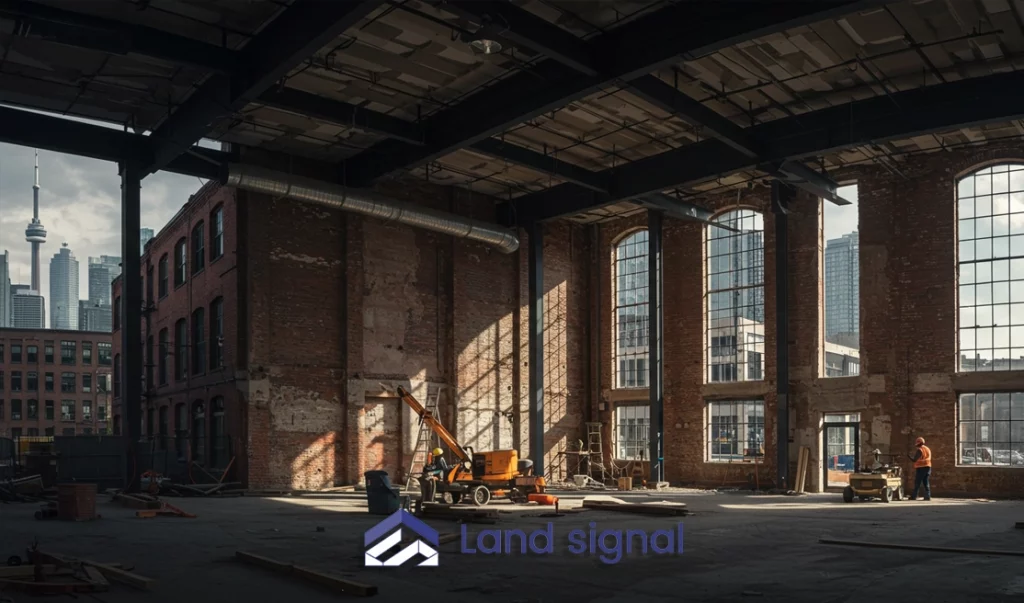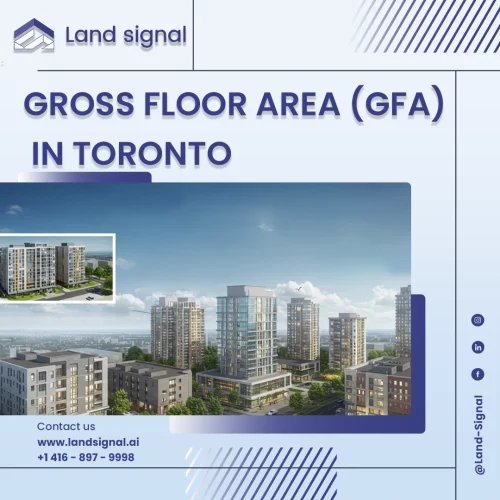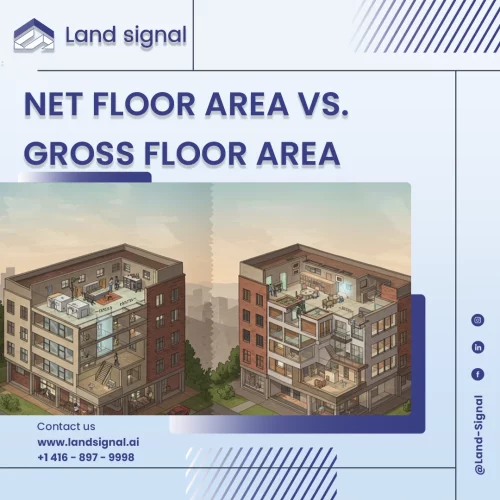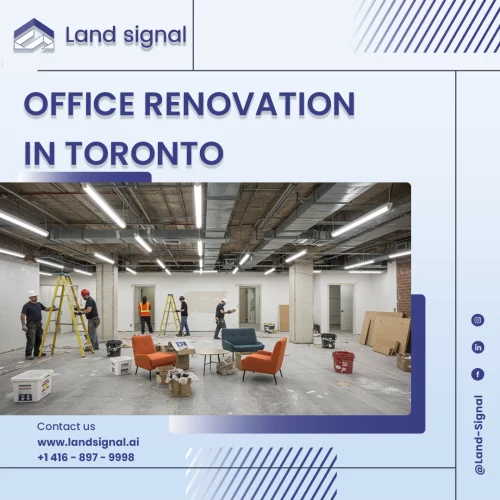In cities like Toronto, industrial renovation is becoming an increasingly popular solution for revitalizing outdated spaces. Instead of starting from scratch, many developers are transforming old factories, warehouses and manufacturing facilities into modern, functional spaces that serve a variety of purposes – from office space to retail hubs and even residential lofts. These renovations not only breathe new life into buildings, but also contribute to economic growth and environmental sustainability by reducing waste and conserving resources.
At Land Signal, we make the process smoother by helping you secure the necessary renovation permits in Toronto. In addition, our online renovation cost calculator is designed to help you get a clear picture of your budget, so you can plan your renovation project with confidence, knowing you’re on track financially.
In this article, we’ll explore the benefits of industrial building renovations, the key factors to consider, and the sustainable practices that can make your project more cost-effective and environmentally friendly.
Start Your Project with Confidence
At Land Signal, we assist with construction and renovation permits, as well as Garden House and Laneway Suite designs. Let our experts guide you through every step.
Understanding Industrial Building Renovation in Toronto
Toronto, a bustling metropolis with a rich industrial heritage, has witnessed a surge in industrial building renovations in recent years. Driven by factors such as rising real estate costs, limited land availability, and a growing appreciation for adaptive reuse, industrial building renovation has become a viable alternative to new construction.
These projects often involve converting former factories, warehouses, and manufacturing facilities into modern office spaces, retail outlets, residential lofts, cultural hubs, or mixed-use developments. The city’s diverse industrial landscape offers a unique canvas for creative and innovative renovation projects.
Benefits of Industrial Building Renovation in Toronto
Enhancing property value and functionality
Industrial building renovation can significantly increase a property’s market value by transforming underutilized spaces into functional and desirable environments. Renovations can improve the building’s aesthetics, functionality, and energy efficiency, making it more attractive to tenants or buyers. Modernizing outdated infrastructure and incorporating contemporary design elements can create premium spaces that command higher rents or sale prices.
Community development
Industrial building renovations can play a catalytic role in community development by revitalizing neglected areas and creating new economic opportunities. Transforming abandoned industrial sites into vibrant commercial or residential spaces can attract businesses, residents, and visitors, stimulating economic activity and fostering a sense of community. These projects can also contribute to the creation of new jobs, both during the renovation process and in the ongoing operation of the renovated space.
Environmental advantages
Industrial building renovation offers significant environmental benefits compared to new construction. Adaptive reuse reduces the demand for new building materials, minimizing the environmental impact associated with resource extraction and manufacturing. Renovating existing structures also preserves embodied energy, the energy consumed in the original construction of the building. By extending the lifespan of existing buildings, industrial renovation contributes to a more sustainable built environment.
Key Considerations in Industrial Building Renovation in Toronto
Building Classification
Understanding the building’s classification under the Ontario Building Code is crucial for determining the applicable regulations and requirements for renovation projects. Different classifications dictate specific fire safety, accessibility, and structural standards that must be met during the renovation process. Consulting with a qualified architect or engineer is essential to ensure compliance with building code requirements.
Regulations and Permits
Navigating the regulatory landscape and obtaining the necessary renovation permit Toronto is a critical aspect of industrial building renovation. Renovation projects often require approvals from various city departments, including building, planning, and fire services. Engaging a permit expediter can streamline the permitting process and ensure compliance with all applicable regulations.
Avoid Downplaying the Renovation
Thorough planning and execution are crucial for successful industrial building renovations. Cutting corners or downplaying the scope of the renovation can lead to costly problems and compromise the long-term value of the project. Investing in high-quality materials, skilled labor, and proper project management ensures a durable and aesthetically pleasing outcome.
Paying Attention to Neighbourhood Style
Respecting the existing architectural character and neighborhood context is essential when renovating industrial buildings. Integrating the renovated structure harmoniously into its surroundings enhances the project’s aesthetic appeal and community value. Consider the building’s historical significance and incorporate design elements that complement the neighborhood’s architectural style.
Sustainable Practices in Industrial Renovation
Eco-Friendly Building Materials
Utilizing eco-friendly building materials, such as recycled or sustainably sourced lumber, reclaimed wood, or low-VOC paints, minimizes environmental impact and promotes healthy indoor air quality. Prioritize materials with recycled content, low embodied energy, and minimal environmental impact during manufacturing and transportation. Consider using materials with Environmental Product Declarations (EPDs) and Health Product Declarations (HPDs) for transparency and informed decision-making.
Explore the use of bio-based materials, such as bamboo or hempcrete, for renewable and sustainable alternatives. Implement a material selection policy that prioritizes sustainable and healthy building materials.
Energy-Efficient Systems
Implementing energy-efficient systems, such as high-performance HVAC systems, LED lighting, and smart building controls, reduces energy consumption and lowers operating costs. Optimize building envelope performance through insulation upgrades and air sealing measures. Consider incorporating renewable energy sources, such as solar panels or geothermal systems, to further reduce energy consumption.
Implement energy monitoring systems to track energy usage and identify opportunities for optimization. Conduct energy modeling and analysis to evaluate the effectiveness of different energy-efficient strategies.
Read Also: Energy Efficiency in Home Renovations | A Practical Guide
Adaptive Reuse Strategies
Adaptive reuse involves repurposing existing building elements or spaces for new functions, minimizing demolition and waste generation. Preserve historically significant features and incorporate them into the new design. Evaluate the existing building’s structural integrity and potential for adaptive reuse before demolition.
Consider creative ways to repurpose existing materials and spaces, such as converting old machinery into decorative elements or transforming industrial spaces into open-plan offices. Document and preserve historically significant features to maintain the building’s character and heritage.
Waste Reduction Techniques
Implement waste reduction strategies during the renovation process by diverting construction debris from landfills through recycling and reuse programs. Collaborate with demolition contractors and waste management companies to maximize material recovery and minimize waste disposal.
Conduct a waste audit to identify recyclable and reusable materials. Implement a construction waste management plan to track and manage waste generation. Educate construction workers on waste reduction and recycling practices.
Green Certifications and Standards
Pursuing green building certifications, such as LEED or BOMA BEST, demonstrates a commitment to sustainability and enhances the market value of the renovated building. These certifications provide a framework for implementing sustainable practices throughout the renovation process. LEED certification offers various rating systems tailored to different building types and renovation scopes. BOMA BEST certification focuses on building operations and management practices. Green certifications can attract environmentally conscious tenants and investors.
Cost-Effective Renovation Tips
Utilize Quality Materials
Investing in high-quality, durable materials may have higher upfront costs but offers greater long-term value by minimizing maintenance and replacement needs. Durable materials resist wear and tear, reducing the need for frequent repairs or replacements. High-quality materials often have longer warranties, providing additional cost savings.
Incorporate Modern Technology
Integrating smart building technologies, such as automated lighting controls and energy management systems, optimizes resource utilization and reduces operating costs. Smart thermostats and occupancy sensors can optimize heating and cooling based on occupancy patterns. Energy management systems provide real-time data on energy consumption, enabling informed decision-making.
DIY Where Possible
Undertaking certain renovation tasks in-house, if feasible and safe, can reduce labor costs. However, prioritize safety and ensure proper execution for critical tasks. Simple tasks like painting, demolition, or landscaping can be handled in-house if appropriate skills and resources are available. Prioritize safety and consult with professionals for complex tasks requiring specialized expertise.
Reuse and Recycle
Reclaiming and repurposing existing building materials, such as flooring, fixtures, or structural elements, minimizes waste disposal costs and reduces the demand for new materials. Reclaimed wood can be used for flooring, wall cladding, or furniture. Salvaged fixtures and lighting can be refurbished and reused. Recycling metal and concrete reduces landfill waste and conserves resources.
Read Also: Calculate Your Home Renovation Costs Toronto
Future Trends in Industrial Building Renovation
- Smart Building Technologies: Integration of smart building technologies, including IoT sensors, building management systems, and data analytics, will optimize building performance, enhance occupant comfort, and reduce energy consumption. Data analytics can identify patterns and trends in building performance, enabling predictive maintenance and optimized energy management.
- AI-Driven Renovation Planning: Artificial intelligence and machine learning will play an increasing role in optimizing renovation designs, predicting project costs, and streamlining construction schedules. AI algorithms can analyze building data and generate optimized design options based on specific project requirements.
- Energy-Positive Buildings: Renovations will increasingly focus on creating energy-positive buildings that generate more energy than they consume, contributing to a cleaner and more sustainable energy grid. Energy-positive buildings can feed excess energy back into the grid, offsetting energy consumption elsewhere.
- Modular & Prefabricated Solutions: Modular and prefabricated construction techniques will gain traction in industrial renovation, offering faster construction times, reduced costs, and improved quality control. Prefabricated components can be manufactured off-site and assembled on-site, reducing construction time and minimizing disruption.
- Net-Zero Renovation: Net-zero renovation aims to achieve a balance between the energy consumed by a building and the renewable energy generated on-site, resulting in a building with zero net energy consumption. Net-zero renovations often involve a combination of energy efficiency upgrades and on-site renewable energy generation.
Read Also: Net Zero Home Toronto | A Complete Guide
Conclusion
Industrial building renovation presents a valuable opportunity to revitalize urban areas, create functional and sustainable spaces, and contribute to economic growth. By carefully considering the key factors, embracing sustainable practices, and incorporating innovative technologies, stakeholders can unlock the full potential of industrial building renovation and create lasting value for communities and the environment.
As urban populations continue to grow and the demand for sustainable building practices intensifies, industrial building renovation will play an increasingly important role in shaping the future of our cities.


